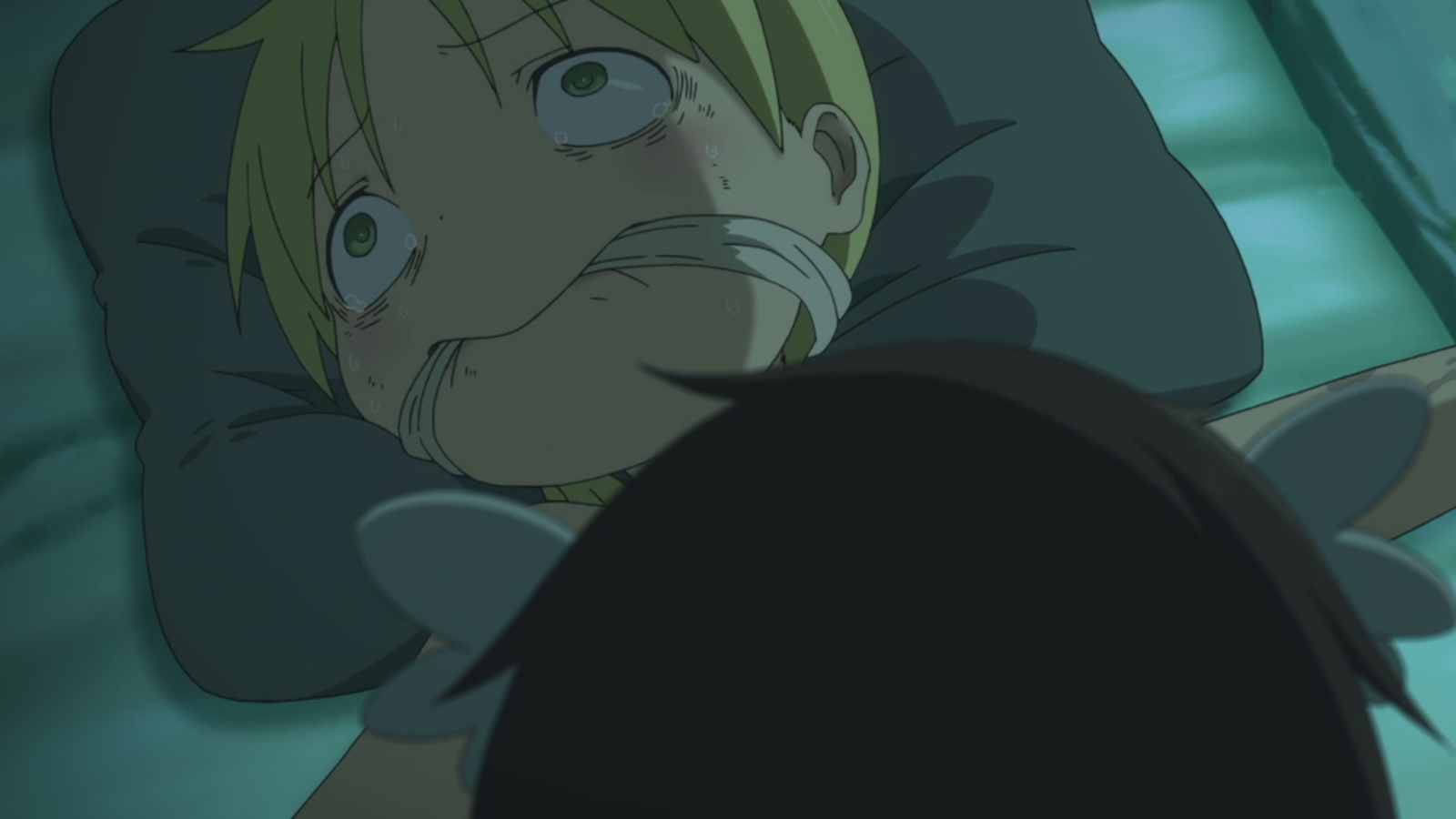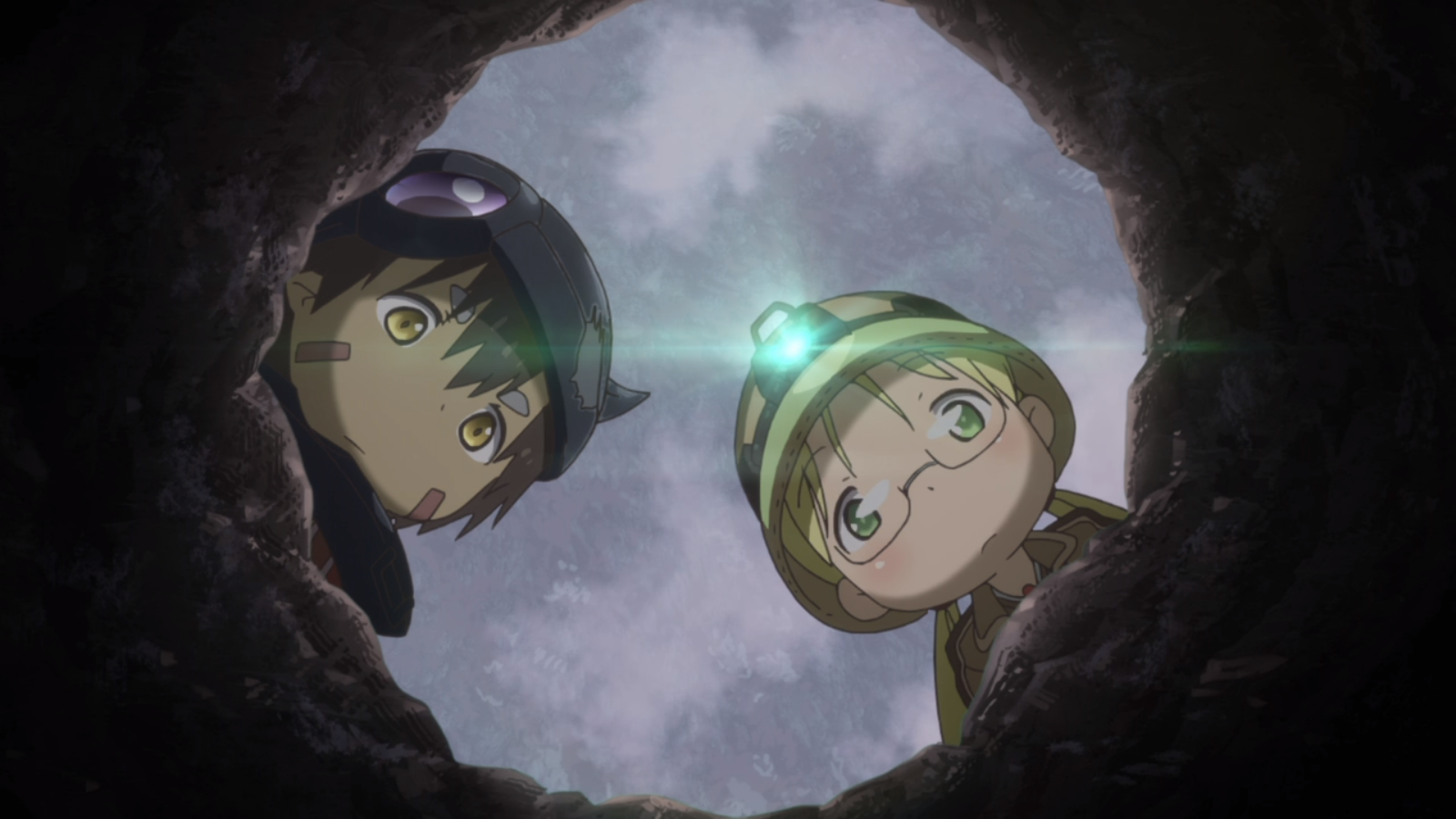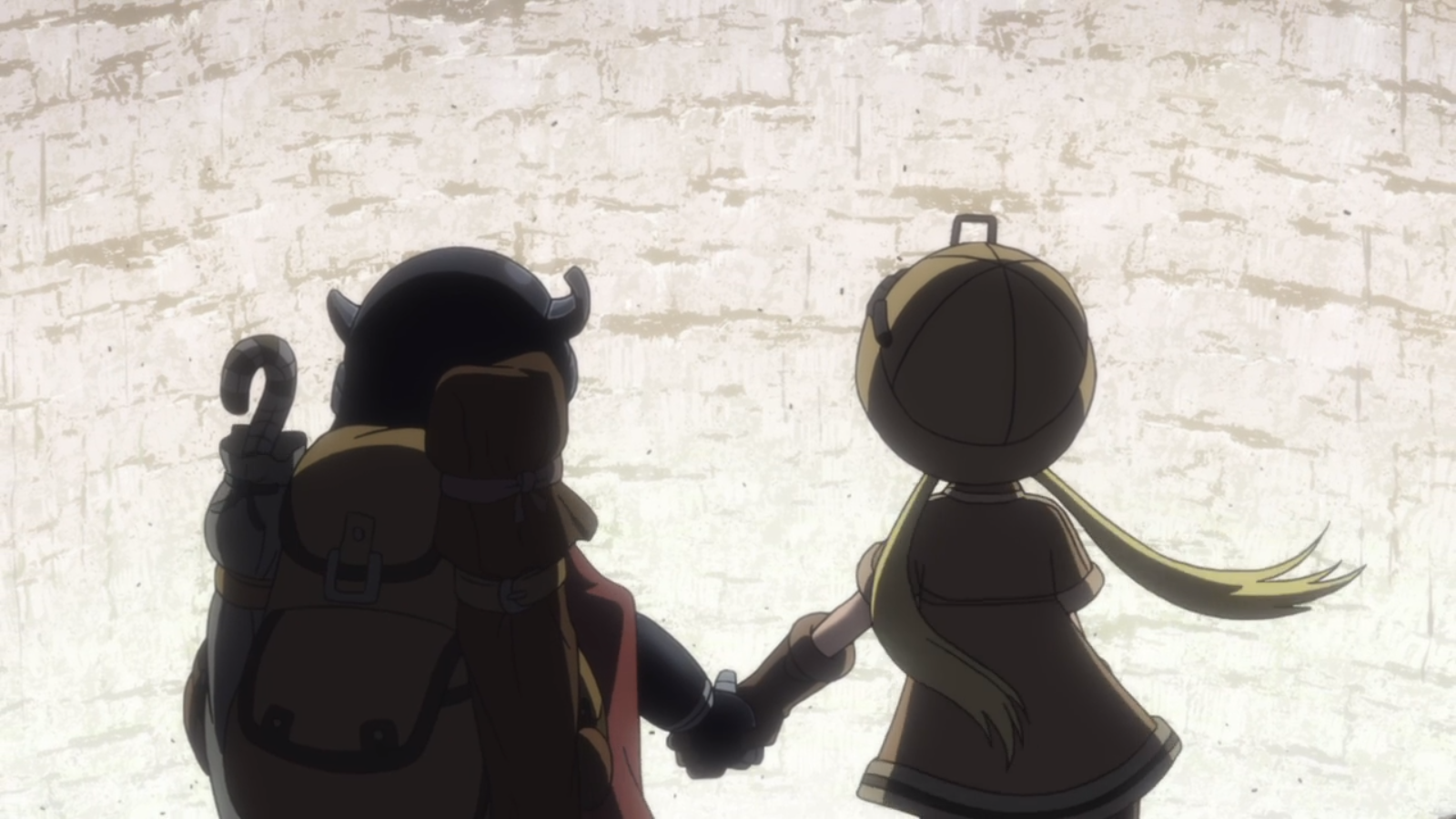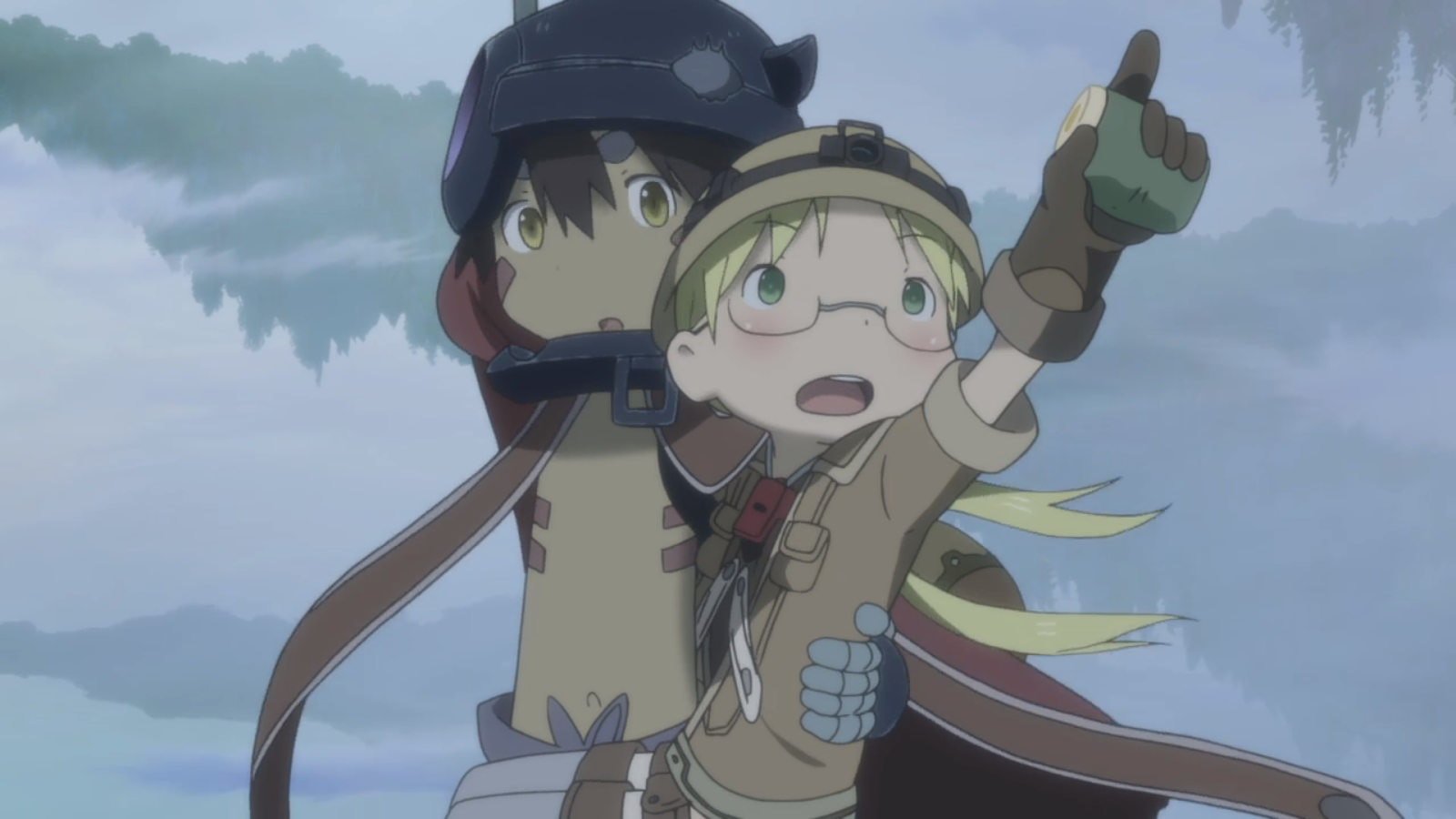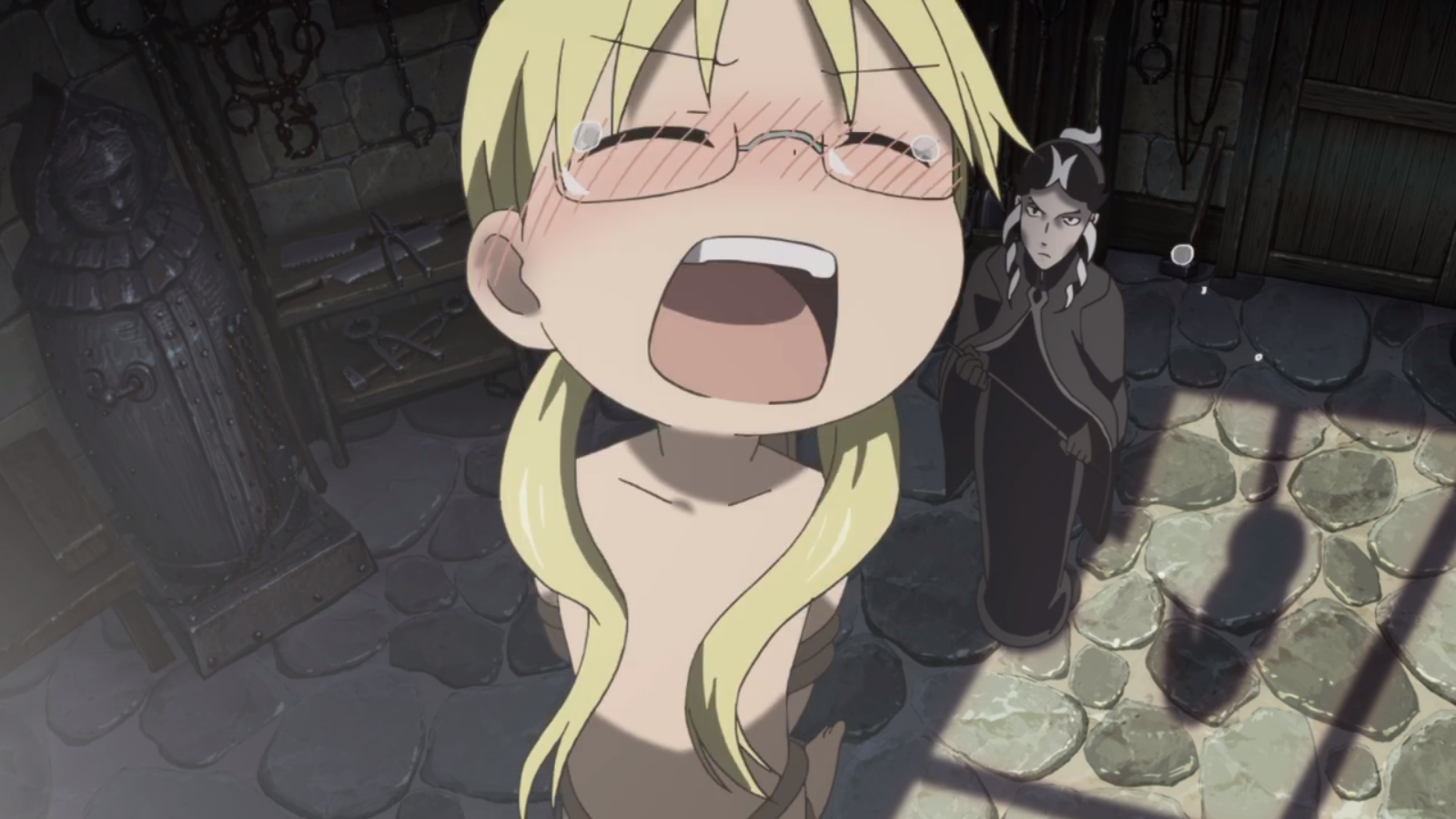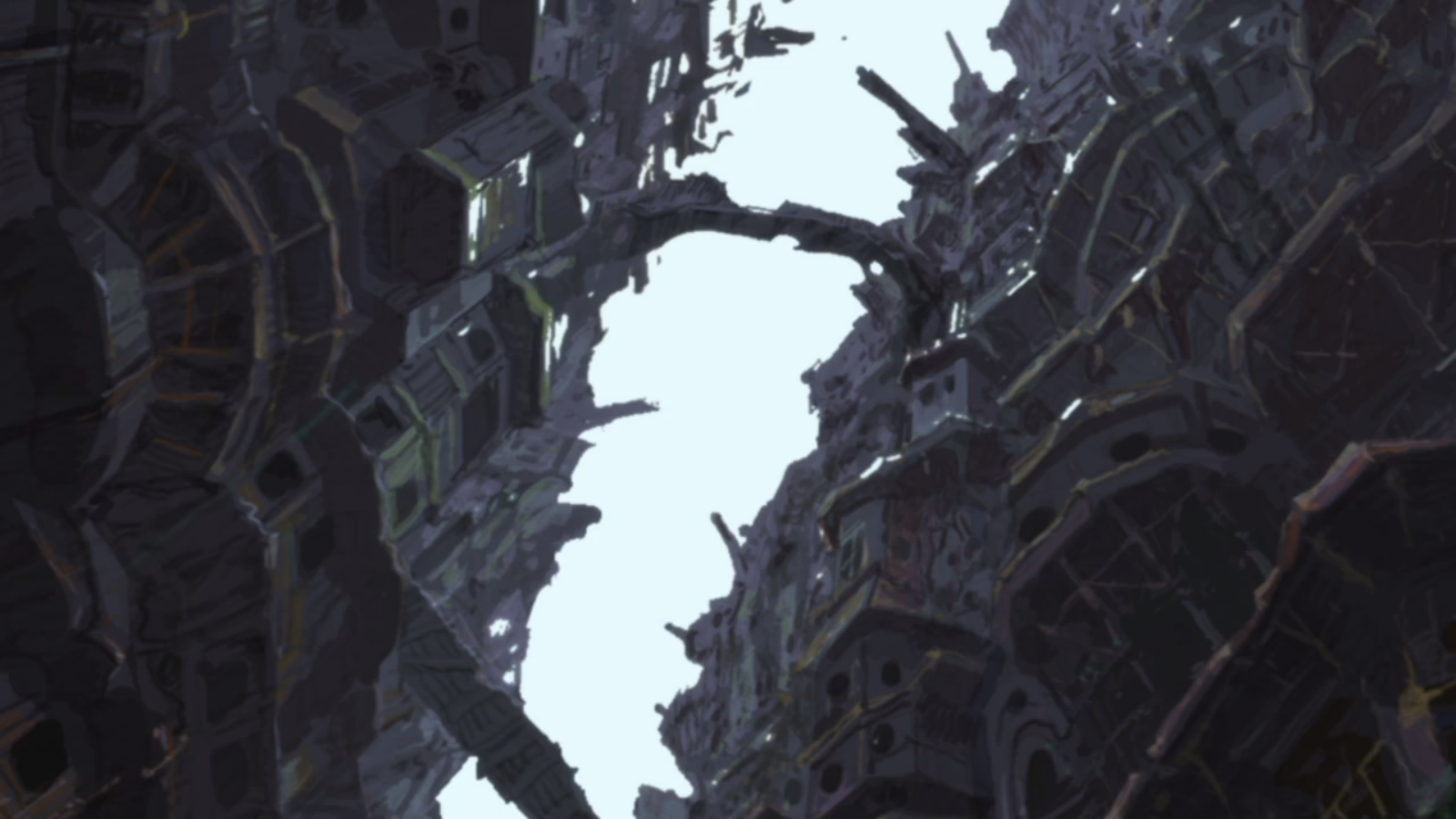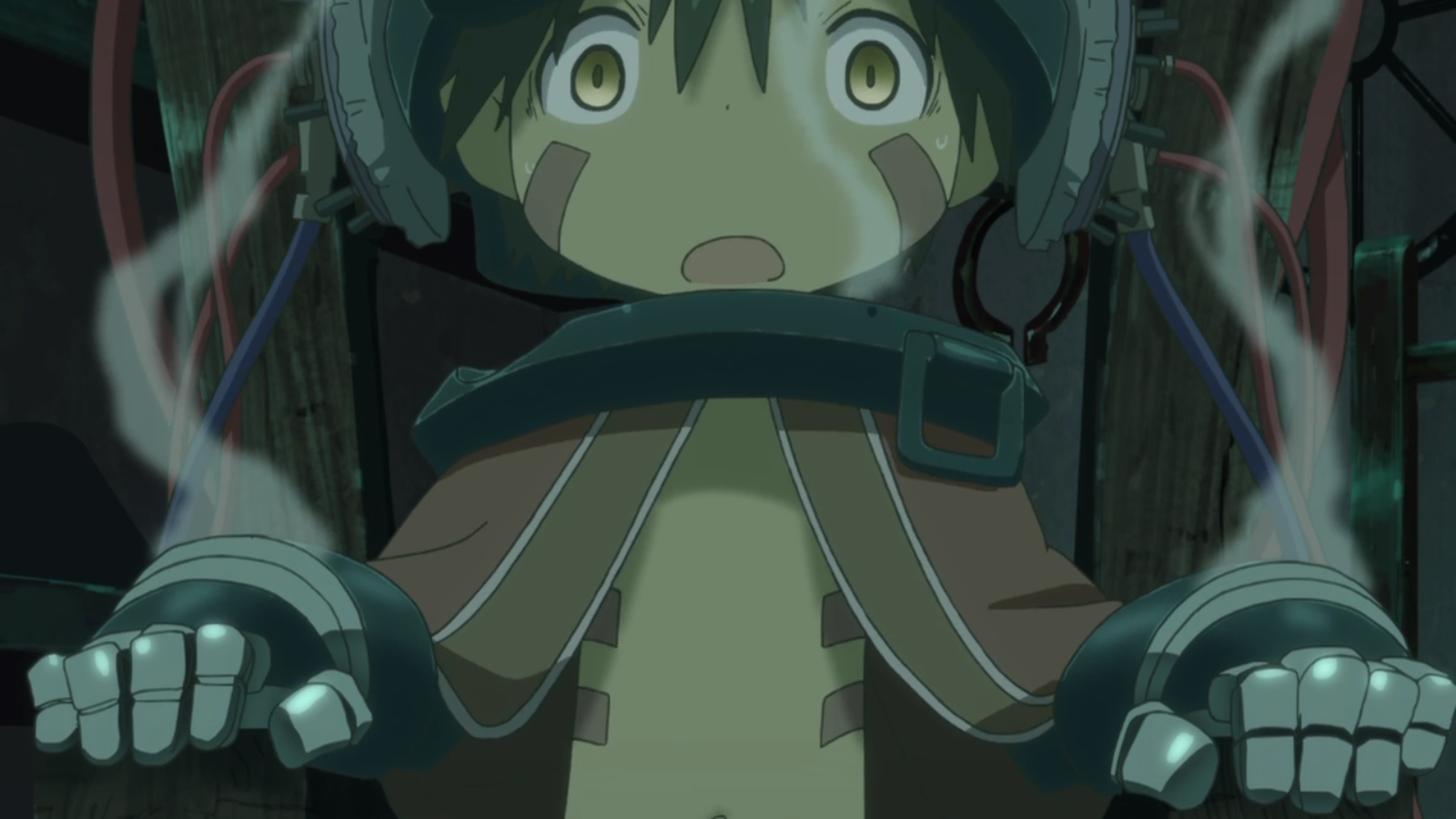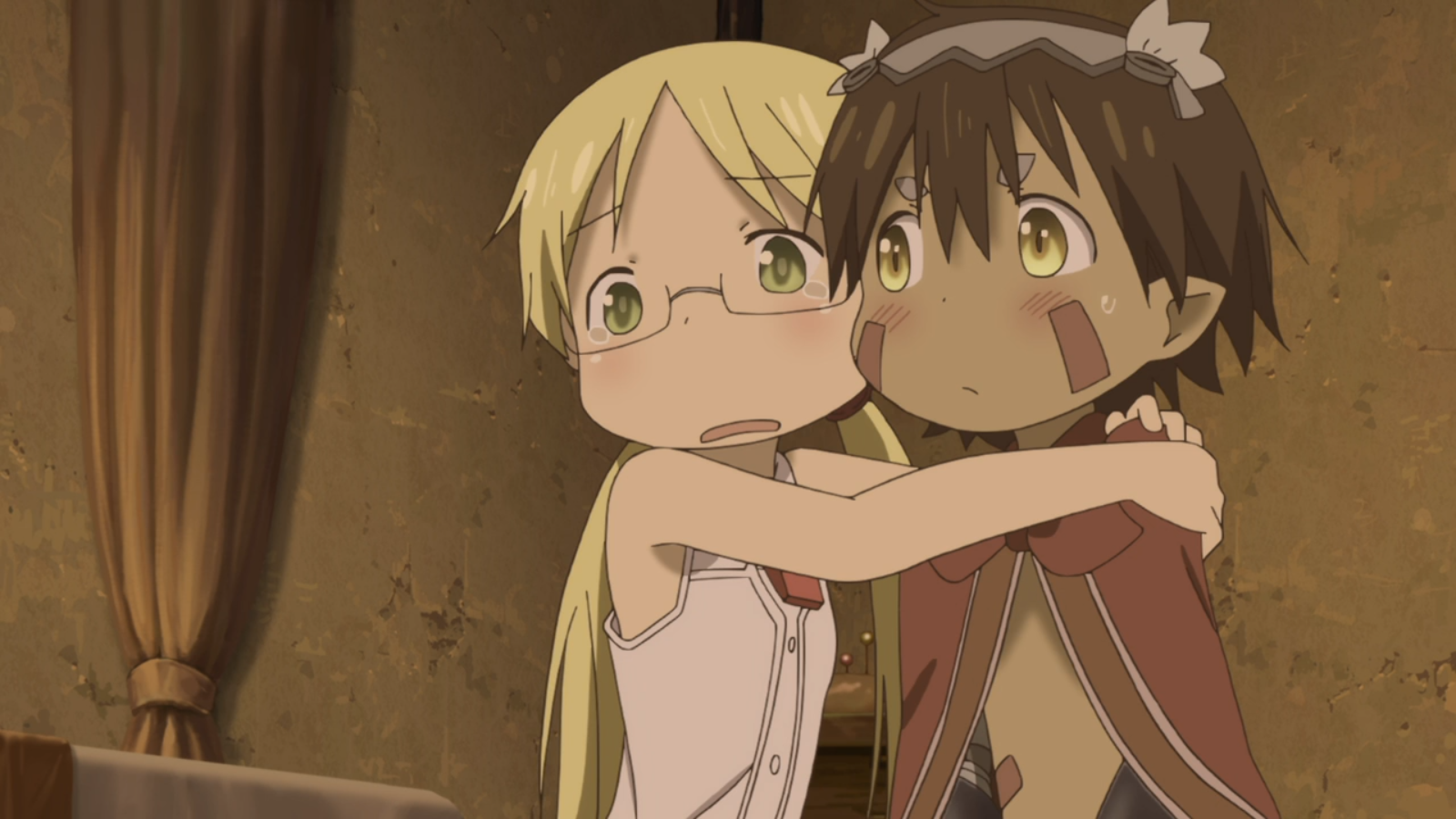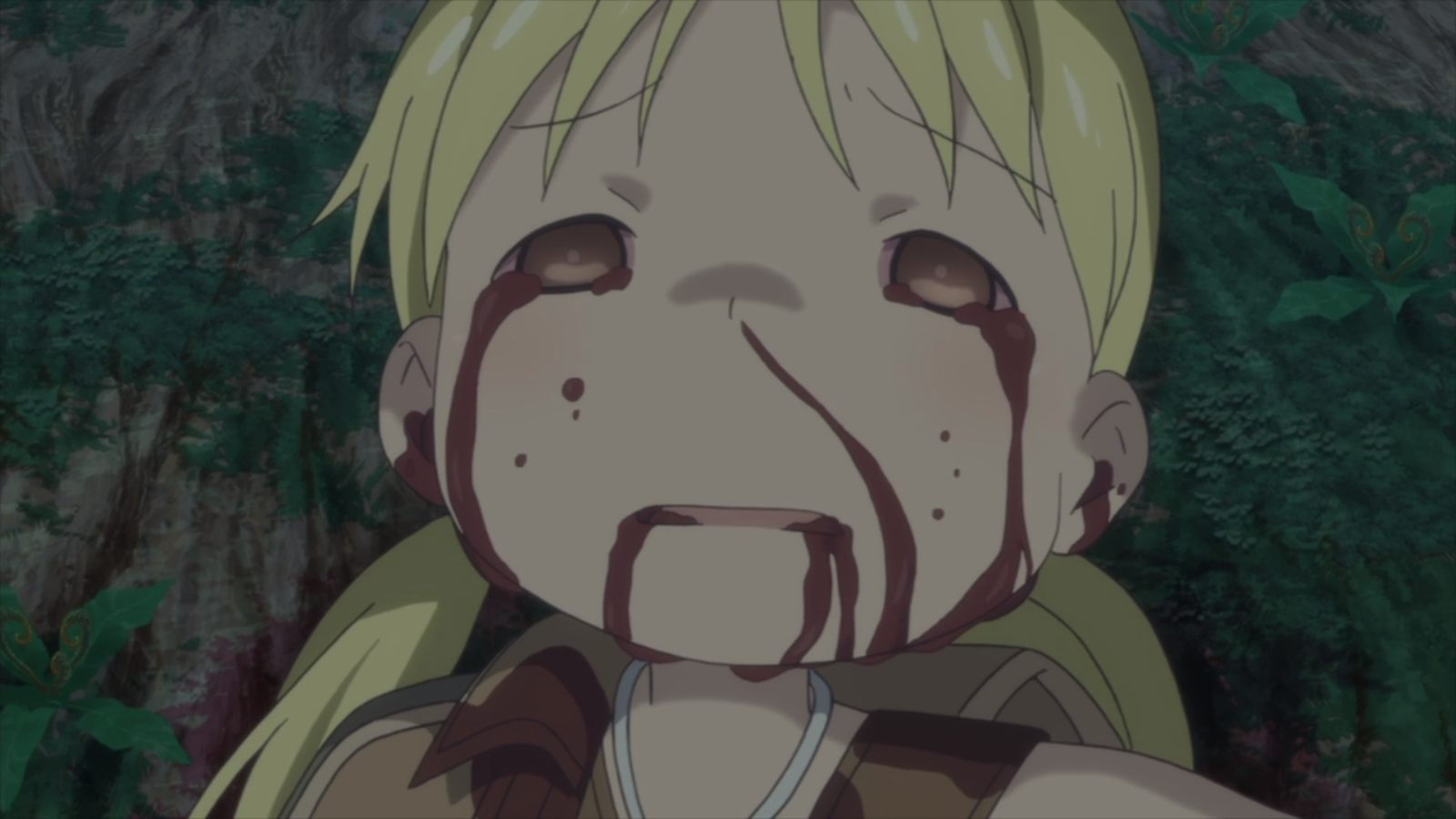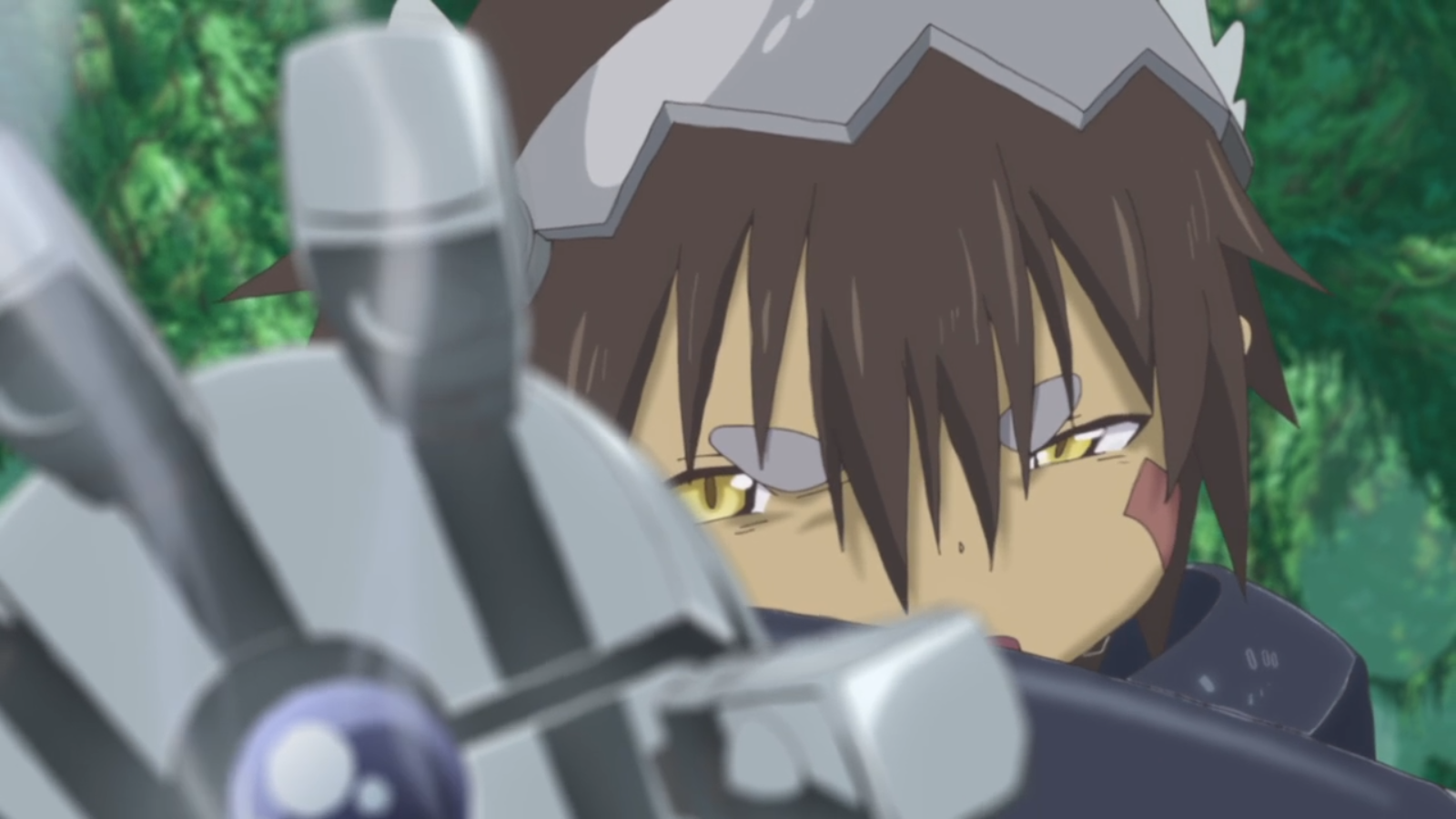Made in Abyss, directed by Masayuki Kojima. Written by Keigo Koyanagi, Hideyuki Kurata, and Akihito Tsukushi. Starring Miyu Tomita, Mariya Ise, and Maaya Sakamoto. Kinema Citrus (). 12 episodes of 23 minutes and 1 episode of 46 minutes (approx. 322 minutes). Rated TV-14.
Available on Amazon Prime and HIDIVE.
When Made in Abyss appeared in 2017, it was the biggest hit of its season, if not the year. It also quickly became one of the most polarizing titles on social media. I was already praising it before it appeared in English simply because I’d caught glimpses of its creator’s art. Then I started to hear … rumors … that made me squeamish—mostly about the manga being a hairsbreadth from lolicon.
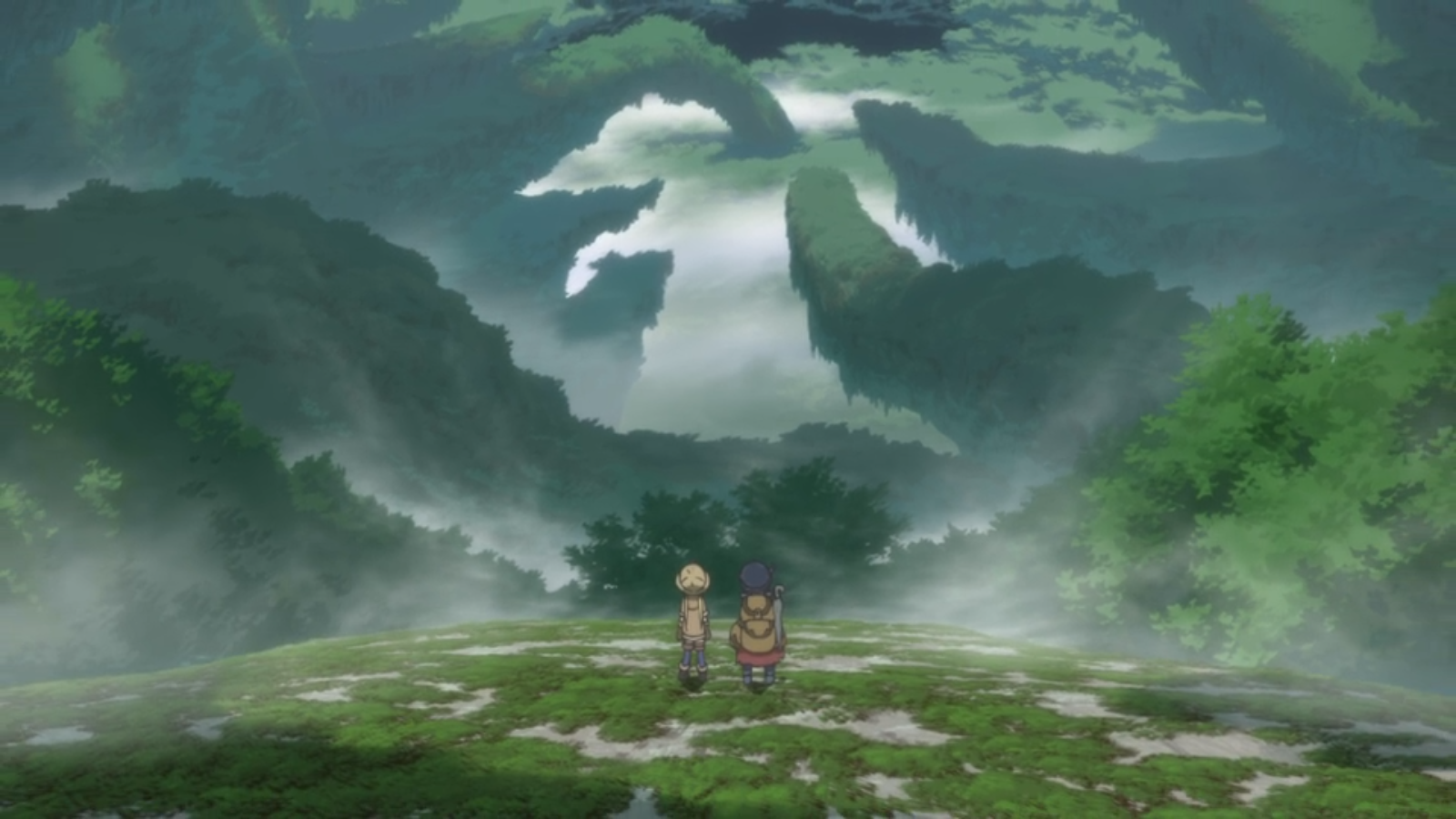 I’ve not had a chance to read the manga, which if I’m not mistaken is still ongoing, but I have finally sat down and watched the thirteen-episode first season of the anime. I can say nothing substantial about its source material (my info is mostly hearsay coupled with some amazing panel art), but I will say that, whatever the manga is like, the anime is really, really impressive. This is one of the best cartoons I’ve ever seen, hands down.
I’ve not had a chance to read the manga, which if I’m not mistaken is still ongoing, but I have finally sat down and watched the thirteen-episode first season of the anime. I can say nothing substantial about its source material (my info is mostly hearsay coupled with some amazing panel art), but I will say that, whatever the manga is like, the anime is really, really impressive. This is one of the best cartoons I’ve ever seen, hands down.
But it has been sharply criticized for—allegedly—sexualizing children. This is a hot-button issue that, alas, frequently affects anime fandom: we recently had the creator of the perennially popular Rurouni Kenshin caught with child pornography, and openly pedophilic anime fans are becoming more visible on social media at the moment, now that they’re fleeing Tumblr for Twitter.
But it seems to me that the two sides of the controversy over Made in Abyss are often talking past each other: I haven’t exactly taken a scientific poll, but at least from what I’ve seen, the title’s defenders usually talk solely about the anime whereas its detractors focus on the manga.
I haven’t read it yet, as already stated, but from what I’ve seen of it, the manga does appear to have some more graphic content than the anime does. I can’t form an opinion on the manga one way or the other at the moment, but I am willing to defend the animated version: I suppose we could question whether this title should have been adapted at all, but, assuming for the sake of argument that all the criticisms of the manga are reasonable, this would hardly be the first time a studio saw merit in something outré and cleaned it up; witness for example Fate/Stay night.
Here, I’m going to talk very little about the manga. I haven’t read it, and I’ll evaluate it separately when I do. The anime is self-contained, so we can discuss it with only occasional reference to its source material.
Summary
We’ll get to the controversy further down, but let us begin by discussing the story and the show’s obvious merits.
The story of Made in Abyss takes place in some strange alternate world, every corner of which has been explored except for one massive, round chasm filling most of an island. The depth of this Abyss is unknown, as no explorer has ever reached its bottom and lived to tell the tale, but it is full of both horrific monsters and fantastic, powerful relics from some bygone age. A huge city, Orth, has grown up around the Abyss’s rim, and its entire culture is based on hardcore spelunking: from an early age, children learn to be “cave raiders” who search the uppermost layer for ancient treasures. As they grow older, if they become more skilled—and if they survive—they can plumb the Abyss’s deeper layers to face more hideous monsters but also find more valuable treasures. The most talented become the barely human “white whistles” capable of traveling as deeply as the fifth layer and surviving the return journey. Some will occasionally travel even deeper than that, but anyone who descends to the sixth layer is making a “last dive,” unable to return.
The story’s heroine is twelve-year-old Riko, daughter of a famous white whistle, Lyza, who birthed her in the Abyss and disappeared into its depths two years later. Riko now lives at an orphanage where she makes her living as a red whistle, looting the sun-drenched uppermost layer with the other orphaned offspring of dead or missing cave raiders. While trying to distract a monster attacking one of her friends, she comes upon a strange boy, Reg, who is actually a robot—a relic himself who apparently reached the surface from some unknown layer of the deep Abyss, though he suffers plot-convenient amnesia and thus remembers nothing of his journey or his past.
Soon after, a seasoned “black whistle” cave raider returns to the surface with several recovered possessions of Riko’s mother, including a strange scrap of parchment bearing the words, “At the bottom of the Netherworld, I will be waiting.”
Convinced this message is for her, Riko steals away from the orphanage, her faithful robot companion in tow, and descends into the Abyss, determined to reach its uncharted bottom to find her mother. Although Riko is young and inexperienced, Reg’s presence gives her an unusual advantage, as he has an ability to fire his forearms like grappling hook guns, and in the palm of his hands has a powerful beam weapons called the “Incinerator,” though using it causes him to fall unconscious for four hours.
On their journey into the bowels of the Earth, Riko and Reg will face surreal and breathtakingly beautiful environments as well as an endless barrage of monster assaults. They will also face the “Curse”: Hovering over the Abyss is an anomaly called a “force field,” which gathers sunlight and beams it down the Abyss’s central shaft, but the force field also produces a more sinister effect; any human who descends into the Abyss cannot ascend again without suffering illness. Rising out of the first layer causes weakness and nausea, but at deeper layers, the consequences of rising even a few meters can be extreme. Although the Curse has no effect on Reg, Riko enters the Abyss fully aware that she will never be able to leave it again.
Discussion
The basic concept—murder hobos trekking underground to fight monsters and loot treasures—sounds as if it got its start as a parody or deconstruction of dungeon-crawler RPGs, but by the time it reached production, it had morphed into something else. The world of Made in Abyss looks like something out of a Romanticist’s fever dream, a bizarre and frightening yet beautiful hodgepodge of otherworldly environments and menacing creatures.
Although this series is enjoyable, I’m going to predict that its ending will be a disappointment, if it ever reaches its ending. There are a lot of mysteries surrounding the Abyss, but most of them could never be explained satisfactorily simply because they defy any reasonable explanation. There are, for example, human bones in the Abyss, all of them positioned the same way with their hands clasped as if in prayer. There are ancient ruins and artifacts, including even the remains of a primeval boat jutting out of a solid stone cliff face. How did these things get there? The characters don’t know, and possibly never will. I found as I watched this show that I really didn’t want to know: the very strangeness of the Abyss is its attraction, and an explanation could only detract from it. The characters are drawn into the Abyss by a hunger for the unknown, and this hunger is infectious. Indeed, the show is to a large extent a paean to curiosity, depicting it as both man’s greatest asset and his greatest weakness, a blessing and a curse.
It would be hard to over-praise the production values of this show. The background imagery is amazingly detailed and consistently gorgeous. The soundtrack, moving between orchestral works and mournful individual instruments, is nearly perfect. The animation is fluid.
The character designs, which fooled a lot of people (me included) into thinking this would be a kids’ show, are done in the highly exaggerated style sometimes called “puni plush.” Since the manga’s creator, Akihito Tsukushi, has drawn fan art for the magical girl show Fairy Musketeers, which uses the same puni plush style, it’s probably safe to say that’s one of the influences. Puni plush is very “cutesy,” and for that reason, most people commenting on Made in Abyss claim that the character designs are a deliberate contrast to the show’s often grim content, but I’m going to break away from the pack by saying that puni plush is exactly right for this kind of story: I’ve stated before, more than once, that I believe cutesy characters are best for grand adventures, including grand adventures with violent elements and harsh themes, and to my mind, Made in Abyss is another confirmation that this theory has weight. If a character’s hardships are to have a full-fledged emotional impact, they must be characters for whom we personally feel some affection. The puni plush style is well-suited for this, because it results in characters that the viewer will just want to pick up and hug. Riko is so pleasant-looking that it becomes hard to watch when she is—for example—bleeding from the eyes while begging to have her infected hand amputated.
There is also a theory of animation that cartoonish characters drawn with minimal detail should be placed in front of highly detailed backdrops. I’ve never heard an explanation of exactly why this works, but it does. Studio Ghibli productions usually follow this theory, and Made in Abyss looks and feels much like something that might have come from Ghibli.
If you peruse the negative reviews that Made in Abyss had got on Amazon, you will see that many viewers were simply unprepared for the show’s grimmer content, but I would reply that some of the harshest sequences in this show are also among the best ever animated. Made in Abyss climaxes with a character getting seriously injured, followed by some very brutal frontier medicine. It is altogether around ten minutes of wince inducement, and it is also incredibly well-directed, moving smoothly from an emphasis on wide shots during the action to intense close-ups during the uglier stuff. Yes, it’s hard to watch, but I will sit here and say plainly that everyone should watch it anyway. Just don’t eat while you’re doing it.
Controversy
For the second time in recent memory, I am putting myself in the unenviable position of defending a cartoon that features nude children. Before I begin, I want to re-emphasize that I’m looking at the anime only, whereas some of the critics of Made in Abyss have looked mostly at the manga, and based on some of the panels they’ve used as examples of what they’re talking about, it does appear that the manga has some more graphic material.
Scene the First
To begin, here’s one of the things that first led to a hew and a cry on social media: Riko mentions in the first episode that the orphanage’s stony-faced headmistress has more than once “strung her up naked” for her misbehavior, and during a montage in the second episode, there is a brief scene, probably less than two seconds in length, in which we see this very punishment being doled out:
That screenshot is almost the entirety of the scene. That’s all we see, but a lot of people have complained that this must be an expression of some kind of sick BDSM fetishism.
While the suspicion is understandable, I don’t think that’s what’s actually going on. If this were meant to be titillating, it would look different. For example, the camera would be in a different place, perhaps emphasizing her legs. As it is, it’s focused on her face, and it admits only enough detail to let us know what’s happening.
There’s also the matter of the headmistress standing behind her. If this were supposed to be suggestive of sadism, her expression would be different also: her eyes would bug out, and her lips would part in a lopsided grin showing clenched teeth—those are the usual symbols in anime of sadistic pleasure. Instead, she’s just standing there holding a rope, looking as if she’d rather be anywhere else.
Some viewers have suggested that this scene is here to give us an impression of just how bad this orphanage is that Riko is fleeing, but I don’t think that’s quite right either. Riko doesn’t leave the orphanage to escape abuse but to find her mother. And there’s a scene in a latter episode in which an adult threatens another child with this same punishment, which indicates that, in the world of Orth, this is considered a normal way to discipline children. That’s implied in the screenshot pasted above, too: Not only does the headmistress give no indication she’s enjoying herself, but she doesn’t simply tie Riko up and leave her. She stays there, apparently to mete out the punishment she thinks is fitting and perhaps to make sure Riko is not actually injured.
So what’s the point of this? I’ve seen some viewers, in trying to interpret this scene, give up and decide it’s just some gratuitous viciousness that serves no purpose. That’s not unfair: It is certainly a grotesque detail, and the story would have suffered no detriment by going without it.
But what I think is going on here is a statement on the culture of Orth: Remember, it’s an entire city based around cave-raiding. All the orphans at this orphanage are children of cave raiders, and they are cave raiders themselves. The town itself has an abyss-like look to it, with canyon-like streets and high building interiors.
Even the classroom where Riko goes to school (to learn about cave raiding) is constructed with desks that are not laid out in rows but instead mounted on a wall and reached by rope ladders.
We soon learn that exploring the Abyss involves incredible hardship, extreme pain, and ultimately death. Even these young kids go through a nightly ritual of flu-like symptoms when they rise from the first layer at the end of a hard day’s digging. What I think Made in Abyss is trying to convey is that Orth has developed a form of punishment for children that is as harsh as the conditions for which they’re being prepared. This is, in other words, a part of their training.
One way or the other, it is not presented as something we’re supposed to like. That being said, the discussion devoted to it clearly indicates that it distracts from the show rather than adds to it.
Scene the Second
When Riko discovers Reg, he’s unconscious. She quickly realizes that he’s a robot with synthetic skin and instantly becomes excited. Instead of handing him over to the grownups with the rest of her artifacts, she finds a way to sneak him into her room at the orphanage—
Wait a minute … I just realized, she gets her own room in an orphanage. That’s pretty swank.
But anyway, she gives Reg a thorough examination and runs various intrusive tests on him. This is portrayed as humorous, but in a dark kind of way, since she does everything from stabbing him with knives to running electricity through him to ramming a yard stick in his anus.
When he wakes up, Reg is naturally horrified and embarrassed by all of this. The show has a lot to say about curiosity, and the way explorers will risk life and limb to reach some uncharted place. Riko is a kind of living embodiment of human curiosity: she is never satisfied not knowing, and she also has no “filter”; that is, she doesn’t understand when she’s gone too far or said too much. That’s what’s being portrayed with all of this.
Scene the third, &c.
There are additional scenes after this in which Riko is without clothing, usually because she’s bathing or for medical reasons. Again, the way these scenes are depicted does not suggest any attempt at titillation. They lack the angles and close-ups and emphases that are typical of “fan service.” Indeed, when Riko is without clothing, her body is a flesh-colored blank—and I mean literally blank, like they didn’t even bother to shade in contours.
If this isn’t gratuitous nudity, what is it? Again, I think it’s in part a commentary on the nature of the characters, and especially on the relationship between Riko and Reg. Reg is apparently mechanical, but he is entirely human in his emotions and responses. Riko, however, sees him as a cross between a pet and a toy: she gets excited when she first finds him because he’s a rare relic. Later, she names him after her dead dog. She performs intrusive tests on him, or talks plainly about his physical makeup in ways that embarrass him. Reg views himself as human, but she does not.
She also sleeps with him the way someone might sleep with a pet, and she has no shame in front of him. There is one scene about a third of the way through in which Riko walks out of the bath in front of two others and is unembarrassed because she thinks one of them is a machine and the other is a girl. The irony is that she happens to be wrong on both counts.
Also, we should note that this is a coming-of-age story. The protagonists are of an age where they’ve reached adolescence but are unmistakably not yet adults. This is a story partly about puberty, which is a phase of life that involves a lot of melodrama and a lot of awkwardness. Stories about adolescence will generally involve at least a small amount of bodily humor, simply because embarrassments involving the body are a normal part of life at this time.
And (I speak from experience) it can be difficult to know, when writing these sorts of stories, exactly where the line is, exactly what’s in keeping with propriety and what is not. The task is probably more difficult nowadays when the boundaries of propriety have been obscured if not openly attacked. I think the anime version of Made in Abyss handles this challenge pretty well, with only one real misstep at the end, a needlessly crass joke in the final episode. My preliminary opinion of the manga, based on some pages shown me of it, is that it oversteps the line at times, and falls into what I call Brighton Beach Memoir syndrome, or BBMS, a debilitating condition in which a writer who wants to depict the discomforts of adolescence drags his jokes on too long so that his material feels uncomfortably like one of those hygiene videos with which they torture public school students.
The animated version of Made in Abyss, however, has so far managed to dodge BBMS.
Scene the sixth or thereabouts
The final cause for objection is the depiction of frontier medicine at the show’s climax and conclusion. I’m honestly not sure why this gets objections, unless people are simply shocked by how grisly it is. I think it’s brilliantly written and directed, though I also couldn’t bring myself to look at the screen through the whole sequence.
There are a number of details that might seem crude, but which appear plausible, at least to a layman: a character wetting herself while in extreme pain, or a character being unable to give an unconscious patient medicine orally and so delivering it instead as a suppository. It’s gross, sure—but doctor stuff can get pretty gross. None of it comes across as voyeuristic, or as some kind of sick humor.
Conclusion
While arguing over whether the content is too graphic, I think people have been distracted from some of the story’s actual shortcomings. On the moral side of things, the really objectionable part isn’t the fact that the protagonist undresses to bathe. It’s the mercy killing. But even that is presented, I would say, more as a raw fact of the brutal world the characters inhabit than as some kind of statement on real-world euthanasia. It’s also halfway Faustian: Reg encounters a girl preparing to commit a murder-suicide, and he agrees to commit her murder for her if she foregoes the suicide. It’s as dark and nasty as, well, pretty much everything else in the show.
There’s also a breakdown in the world-building as the setup begins for the next season’s story arc (the next season is slated for some time in 2019): we have a villain who’s got some kind of giant base in the Abyss’s fifth layer, and he even has a rail transportation system going all the way down there from the surface—which makes no sense, given how difficult it is to reach the Abyss’s lower levels, and what a massive construction project this would have been. Maybe this will all get handwaved somehow in the next season, but as it stands, it’s easily the story’s biggest flaw.
This flaw, when considered, also leads to some issues with fridge logic, probably the biggest of which is, why do the cave raiders go underground in such small groups, and without weapons? The only weapons we hear of are relics scrounged from the Abyss itself. Most or all of the white whistles are augmented in some way by relics, and Riko at one point receives a weaponized pickax, itself a relic, that belonged to her mother. It’s curious, though, that the characters don’t enter the Abyss with conventional weapons: given the monsters, you’d think they’d be going down there with small, heavily armed armies, but the cave raiders we see don’t even carry so much as a pistol.
But even with these issues, this is easily one of the best anime of the last few years. I would put it up there with some of the best of all time. I definitely recommend it.
